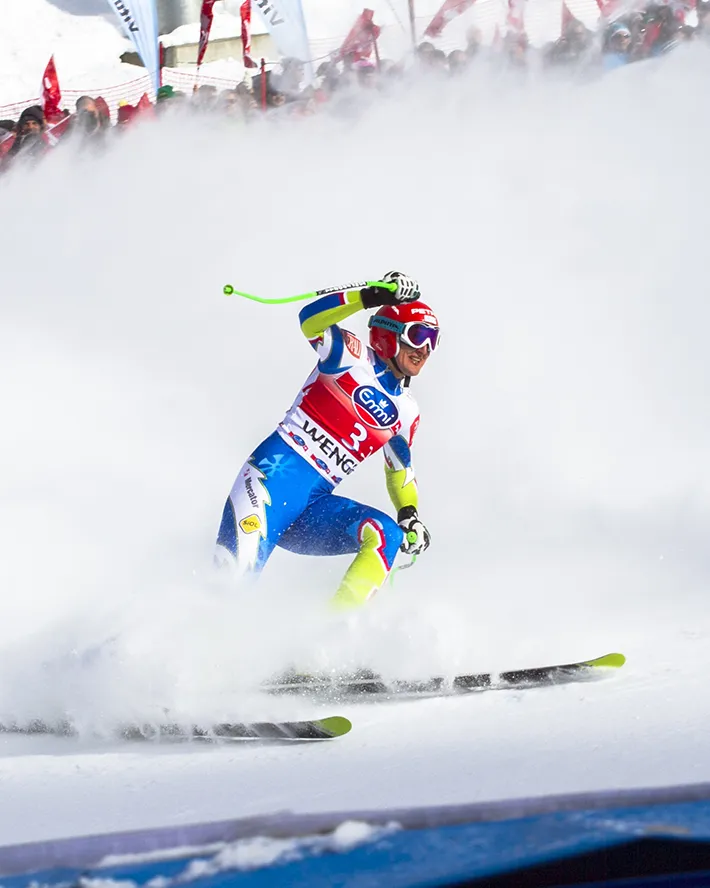Ski racing has a rich history dating back to the early 20th century, when the sport first began to gain popularity in Europe and North America. Over the years, many legendary ski racers have emerged, pushing the boundaries of what was thought to be possible and leaving a lasting impact on the sport. In this blog post, we will take a look at some of the pioneers who changed the game and helped shape the sport of ski racing into what it is today.
Technique and tactics for skiing steep slopes
If you want to be a good all-mountain skier, then you'll need to know how to ski on steeper slopes. Like mogul skiing, these present psychological, technical and tactical problems. In many ways I believe that the psychological factors are more important in steep slope skiing than anywhere else on the mountain. Standing at the top of a steep piste can feel very intimidating, It's easy for negative thoughts to dominate- what if I fall? How far will I slide? What if I can't control my speed? Have a look at the video below, featuring the Manni Pranger piste, the steepest piste in Austria, and think how you'd feel if you were standing at the top about to launch yourself down. If the answer is nervous or frankly scared, then read on to the text below for some tips on steep skiing.
I think the key to conquering steep slope skiing lies in two areas- firstly, technical preparation. It's a lot easier to be positive if you're confident that you have the technical toolkit to handle steeper slopes. Secondly, developing the correct psychological focus to help you stay in the present, concentrating on what you have to do to get down the slope, rather than thinking about what might happen if it goes wrong. I'll deal with each of these in turn.
Technical Requirements for Good Steep Skiing
The techniques that help with good steep skiing actually overlap quite considerably with the skills that help with good bump skiing, so once you've finished reading this blog, do head over to our mogul technique blog for additional material on drills that will help with both types of skiing. But sticking with this blog for now, the key technical requirements for good bump skiing are:
1) The ability to develop a good range of rotation of the skis. Note that most of this rotation will come from the hip joints rather than the knees and ankles. You can prove this to yourself by sitting on a chair with your knees bent to a right angle. Without moving your thighs, lift each foot off the ground and see what angle you can make by twisting your foot inwards- typically this will be about 20-30 degrees from the midline. Then stand on one leg, flex the other leg so that the knee is at a right angle, then twist both the thigh and foot inwards. You'll be able to get vastly more foot rotation- perhaps about 70-80 degrees. So remember, when you're training ski rotational movements, you really want to concentrate on learning to twist the skis by rotating your hips, as well as your feet. Here is a video that demonstrates a few drills to develop this rotational movement:
Note that while he's talking in the video about foot rotation, mostly it's movement at the hip joint that causes this rotation, rather than rotation of the feet themselves. If you try this drill, really focus on feeling how your hips are rotating. Note also that it's very important that the skis are flat on the slow when the rotational force is applied- it's really difficult to rotate an edged ski. On steeper slopes (unless you're racing!) we're mostly aiming to control speed, and for the most part edging only occurs at the very end of the turn, where it's used to check speed and, by using the rebound, give a bounce into the next turn.
2. Rotational separation. Essentially rotational separation means keeping your upper body steady and facing down the slope, while the legs are twisting/rotating beneath it. It's particularly important for scenarios where short radius turns are important, such as skiing on steep or narrow slopes, or skiing in bumps. Again, I mention this in the bumps technique blog, so check out the videos there for additional drills, but sticking here, I've pasted a video below that combines drills for rotation and rotational separation:
Finally on technique, here's another great video from the guys at SkiSchoolApp.com that puts all of this together, and also emphasises the importance of projecting the hips downhill with each turn, which helps with good balance on steeper pitches.
Psychological tricks to help with steeps
Now to the psychology- how do you deal with the fear? I would suggest thinking about a couple of approaches. Different people with like different approaches, but at least one of these will click with you.
1. Give your emotion a name. Mindfullness practitioners say that It often helps to minimise negative feelings if they are given a name. So if you're at the top of the slope feeling uncofortable, stop for a second and ask yourself what that feeling is called- is it fear, is it anxiety? Don't judge it or yourself, just accept that is how you are feeling. The act of recognising it can diminish it.
2. Visualise success. Many athletes use visualisation techniques before competitions, to become clear in their mind what they wish to achieve, and to get into a positive mindset. So visualise yourself skiing the slope well, in perfect control and with enjoyment.
3. Focus on now. Once you start skiing, really focus on the instant you're in, and what you're going to do in the next few seconds. One technique that can be really helpful is to focus on the spot where you want the next turn to finish- on steep slopes, as you start each turn look at a spot two metres downhill and one metre behind you and aim to turn to that point. Not only will this keep your mind clear, but it will also help you get into a good rotationally separated position.
4. Keep fluid by counting your turns. Often people have a tendency to do a few turns on a steep slope, then stop. Each time they stop gives more opportunity to overthink and panic. Psychologically I think it's better to keep going and one way you can help yourself do this is to decide on the minimum number of turns that you're going to do before you allow yourself to stop, then count these out as you're skiing. I'll usually go for a minimum of 10 turns, and on many steep pitches I find that I'm often at the bottom of the steep section by the time I've finished counting. If things are going well, I'll just reset and count to another 10 without stopping.
Finally, I'll also say a quick word about tactics for skiing steep slopes. For pisted slopes, an easy win is to ski at the side of the slope. Most skiers will head down the middle, and so the snow here tends to be scraped and is often hard or icy. The good snow gets pushed to the side of the piste, so it's usually easier to get nice grippy turns there.
That's all for now on steep skiing. I hope these few videos and comments helpful. Of course, if you need any equipment to protect you from the odd epic fail while skiing the steeps, do check out our main website here: Gravity Protection. Also check out the other blogs for more tips on ski technique, ski racing, ski equipment and ski safety, especially avalanche safety and education.



Thank you for explaining how to ski slopes steps by steps, I watched the videos as well and it all comes together really well. I hope I have conquerer my fear and just listening to the techniques I will feel confident all ready.